Handling Cheques, Playing the Game
How to Deal Blackjack: Part 5
Table of Contents
- The Basic Skills for Handling Cheques
- Stacks
- The Game
- Hitting the Player’s Hand on a Shoe
- Hitting the Player’s Hands On A Handheld
- Hitting the Dealer's Hand
How to Deal BlackjackFurther Reading
- Part 1: Introduction
- Part 2: Shuffling
- Part 3: Washing Cards, Cutting Deck, Burning Card, Drills
- Part 4: Delivering Cards, Pitching, Tucking Hole Cards, Checking Ace & 10
- Part 5: Handling Cheques, Playing the Game
- Part 6: Take & Pay Procedure
- Part 7: Player’s Actions & Blackjack
- Part 8: Color Up, Dead Game, & Other Procedures
- Part 9: Dealer’s Break, Tokes, Customer Service & Other Policies
- Part 10: Game Security
Did this free course help you?
Click to leave a tip to help keep this resource free!
The Basic Skills for Handling Cheques
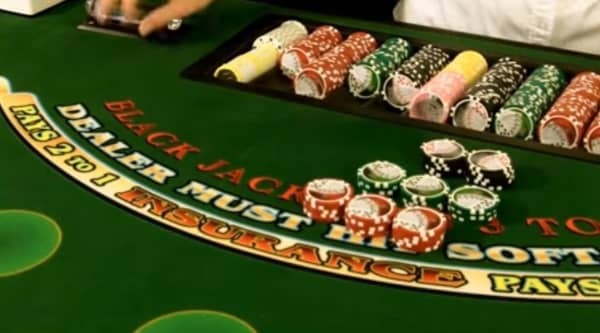
Most of the dealer’s time is spent handling cheques; that is why it is important to practice this at home. You will cut cheques when you make change, pay or take bets, and when you verify a bet. The reason why cheques are used is because it makes it easier and faster to deal a game, and the cheques are easier for the cameras and the floor to read. Always keep the higher denomination closest to you so you can protect those chips. Crumpled bills everywhere would slow things down to such a crawl that no one would ever want to gamble.
Cutting the Cheques
This a term used to describe the physical act of handling the cheques. The word originates from the act of using the forefinger to separate a stack of cheques.
Sizing Into the Bet
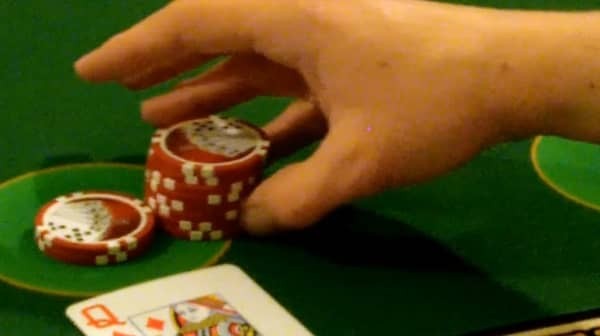
This is the standard way to cut cheques because it is fast, easy to see and because it provides good game protection. Sizing into the bet makes it hard for a nervous break-in dealer to mess up.
To start the procedure, grip a small stack of cheques in your hand and use your thumb and pinky to push the bottom of the stack next to the bet.

Place your forefinger on top of the bet and slide the tip of your forefinger back into the stack your holding as you lift up, leaving a stack the same size as the original.
Never drop cut on a blackjack game; for games such as craps and roulette drop-cutting is useful. The reason why you’re not allowed to drop cut is because it is easy for a dealer to cheat by over paying the player’s bet.
Picking
This is a very useful skill when getting cheques out of the rack. You will usually pick up no more than 5 cheques at a time. The procedure for picking cheques starts with reaching into the rack.

Use the index finger and thumb to pick out the required amount while keeping the chips in between your two fingers. When the required amount is picked you will deliver the cheques.
Bridging
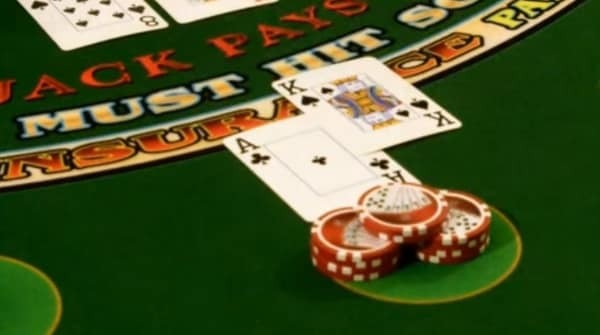
There will be times when you need to bridge the cheques. Size into the bet and place the extra chips on top of the two bets. Bridging the cheques makes the bet easier to read for both the player and cameras. When paying a bet never splash the cheques, always bridge them.
Stacks
The cheques are stacked in a set of 20. A good floor will be able to tell a proper stack just by looking at it or feeling it. Experienced dealers, floor and camera surveillance can easily spot a stack of 5. Each denomination has a total set amount per stack of 20. One stack of $1 cheques equals $20. One stack of $5 cheques equals $100. One stack of $25 cheques equals $500. One stack of $100 cheques equals $2,000. And, one stack of $500 cheques equals $10,000. If there is a pile of chips, of the same denomination, on the betting circle, then that pile must be broken down into stacks. There are two methods for doing this.
The first method is used if the cheque denomination is a $1, $5, $100, $1,000, or $5,000.
-
If the pile is between 1 and 5 cheques then that pile is 1 stack.
-
If the pile has 6 cheques then it is broken down into 2 stacks of 3 cheques each.
-
If the pile has 7 cheques then it is broken down into 2 stacks of 3 cheques each plus 1 on the side.
-
If the pile has 8 cheques then it is broken down into 2 stacks of 4 cheques each.
-
If the pile has 9 cheques then it is broken down into 2 stacks of 4 cheques each plus 1 on the side.
-
And if the pile has 10 cheques then it is broken down into 2 stacks of 5 cheques each.
When handling a 20 stack of $1,000 or $5,000 cheques always prove the last stack, of 5 cheques, by 2 stacks of 2 cheques each plus 1 on the side. $500, $1,000 and $5,000 cheques are not to be used unless directed by the floormen.
The second method is used if the cheque denomination is a $25 or $500.
-
If the pile is between 1 and 4 cheques then that pile is 1 stack.
-
If the pile has 5 cheques then it is broken down into 1 stack of 4 cheques plus one on the side.
-
If the pile has 6 cheques then it is broken down into 2 stacks of 3 cheques each.
-
If the pile has 7 cheques then it is broken down into 2 stacks of 3 cheques each plus one on the side.
-
If the pile has 8 cheques then it is broken down into 2 stacks of 4 cheques each.
When handling a 20 stack of $500 cheques always prove the last stack, of 4 cheques, by 2 stacks of 2 cheques each. All money transactions must be seen from all sides and plainly understood. Never stack cheques higher than their max and use equal stacks when possible.
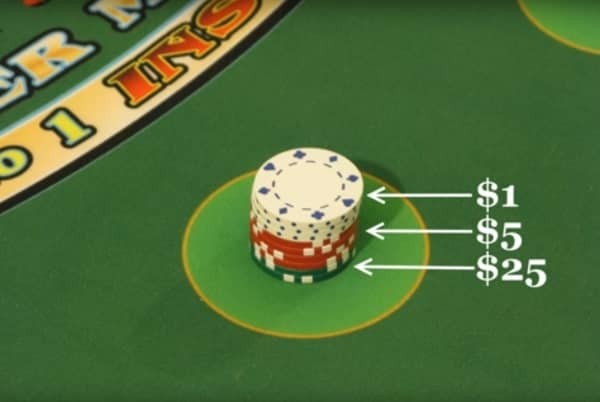
Player’s must stack their multicolor bets in a certain order so the bet isn’t messy or hard to read. The largest denomination must be on the bottom, 2nd largest will be above that and so on until the smallest is on top. When paying a multicolor bet, break down the bet into stacks of the same denomination and then size into them. Leave the cheques broken down; it’s the player’s responsibility to stack the cheques back up. According to people who have been in the industry for a long time, the quieter you handle cheques the better of a dealer you are.
The Game
All bets must be made in the betting circle. Money or cheques that are outside of the circle or in between the circles are to be considered invalid. Say “No Bet” and push the cheques back towards the player. Scan the layout to make sure that there are no players betting under the minimum or over the maximum, and that the cheques are stacked correctly before you deliver a card. Once the card is dealt there can be no changes to the bet. On a handheld deck, the players can only touch the cards with 1 hand. Do not let them hold the cards with two hands. On a shoe, the players may not handle the cards. If a player touches the cards don’t overact, explain the rules politely. Players should never touch other player’s cards or the dealer’s cards.
Hitting the Player’s Hand on a Shoe
Now that the cards have been dealt, it is time for the players to make their decisions. Starting with the first bet on the left; wait for the player to indicate their decision with a clear hand signal. Do not take out a card until the player has made the signal. When the player makes a hand gesture, it should always be besides or behind their bet. As the dealer you must make sure that the player never signals over his bet or in front of his cards because this will block the view of the cameras and makes it easier for players to alter their bet. Never accept a verbal direction; the player must give a hand signal because the cameras need to be able to see the player give you his decision as a hand signal. If you ever deal someone a soft hand, for example a soft 13, then you must announce it as “3 or 13”.
Hitting the Player’s Hands On A Handheld
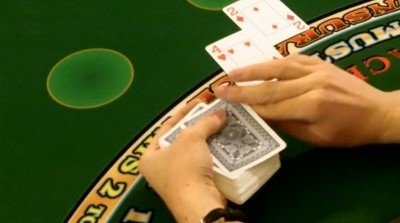
The dealer will use their thumb to push the top card out.
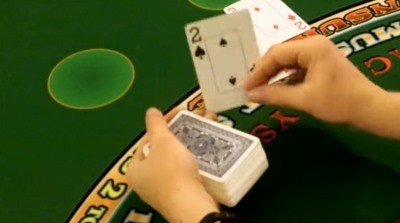
With your right hand grasp the card with your middle finger and ring finger being on top and your forefinger and thumb under the card.
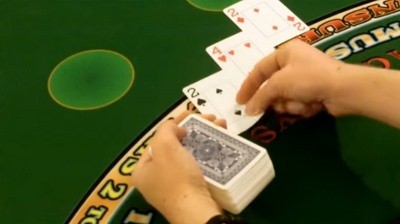
Flip the card from bottom to top. Set the card in front of the betting circle. This is a quick delivery that keeps the dealer in control of how their table looks and keeps the game going.
Hitting the Dealer's Hand
Once all of the player’s hands are done it is time to flip over your card. Take your thumb and forefinger and grip the top card. Use the top card to flip over the hole card and then place the top card to the right of the hole card.
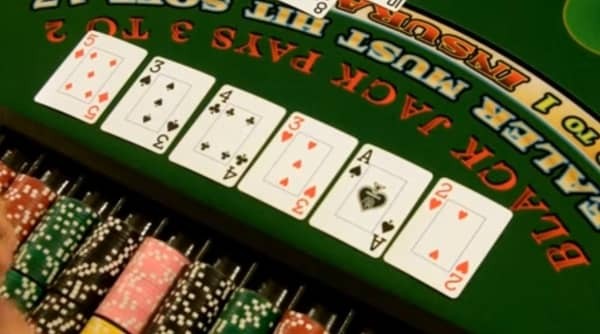
All the additional hit cards must be placed on the right hand side of the dealer’s original 2 cards. The dealer’s cards must have a space in between them and also be in a straight line so that they can be seen clearly by the floor and the cameras.
The dealer must stay on hard 17 and higher, and they must hit on soft 17 and lower. Being a break-in dealer it is a good idea for you to announce the total of your cards before starting the Take & Pay Procedure.
